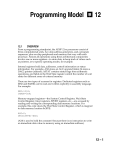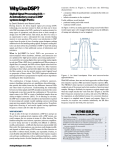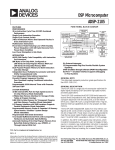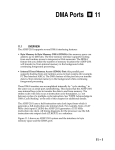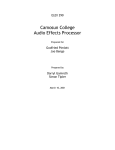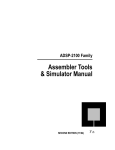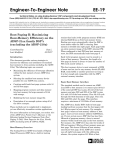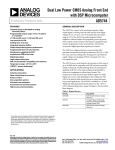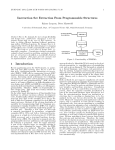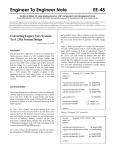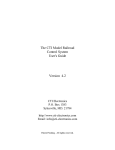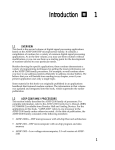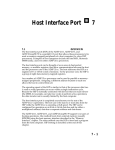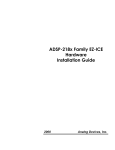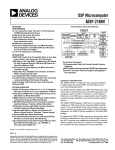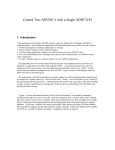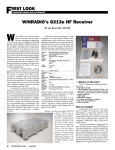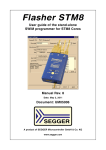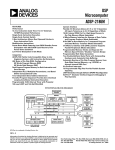Download Engineer-To-Engineer`s Note EE-79 a
Transcript
Engineer-To-Engineer's Note EE-79 Technical Notes on using Analog Devices’ DSP components and development tools Phone: (800) ANALOG-D, FAX: (781) 461-3010, EMAIL: [email protected], FTP: ftp.analog.com, WEB: www.analog.com/dsp Copyright 1999, Analog Devices, Inc. All rights reserved. Analog Devices assumes no responsibility for customer product design or the use or application of customers’ products or for any infringements of patents or rights of others which may result from Analog Devices assistance. All trademarks and logos are property of their respective holders. Information furnished by Analog Devices Applications and Development Tools Engineers is believed to be accurate and reliable, however no responsibility is assumed by Analog Devices regarding the technical accuracy of the content provided in all Analog Devices’ Engineer-to-Engineer Notes. EPROM Booting In Host Mode With 100 Pin 218x Processors Written By: Last Modified: Greg F. 9/23/98 This EE Note will explain how to boot an Analog Device’s adsp218x DSP processor (2184/85/86/87/89) via the Byte Memory interface (BDMA) while it is configured for host memory mode. Host memory mode allows a host processor to boot or access the DSP’s internal memory via the Internal Direct Memory Addressing port (IDMA). Normally, these processors can be configured to boot in only one of two methods; from an eprom (full memory mode), or from a host processor via the IDMA port (host memory mode). sheet, available on our website at the following URL; http://www.analog.com Full Memory Mode Full Memory Mode gives complete use of the external address and data busses as found in the ADSP-2181. In Full Memory Mode, the ADSP-2185/2186 behaves like an ADSP-2181 with the IDMA port removed. There is a 24 bit external data bus, a 14 bit address bus and 5 memory select signals. Byte memory is accessed using the middle eight bits of the data bus for data. The upper eight bits of the data bus together with the 14 address pins provide a 22 bit address for byte memory space. All of these features behave exactly the same as on the ADSP2181. Hold Off cases (autobuffer cycle stealing, external memory accesses with wait states, etc.) are simplified because an IDMA transfer will never occur. In this mode the IDMA port is disabled as if /IS was deselected or pulled high on the ADSP-2181. Overview All of the previously mentioned processors feature a 100pin package which uses a multiplexed external bus that has the following functionality: • Full Memory Mode : Provides complete use of the external address and data busses as found in the ADSP-2181. Allows BDMA operation with full external overlay memory and I/O capability. IDMA functionality is disabled • Host Mode: Allows complete IDMA port operation with limited external addressing capabilities. The functionality of the external bus is dependent upon the setting of the external mode C pin of the processor. The logic state of this pin is acknowledged by the processor during reset; mode C = 0 configures the DSP in full memory mode, mode C = 1 configures the processor in host memory mode. Note: the state of the mode C pin must not be changed once the DSP begins execution. For more information on the operation and configurations of the Mode C pin, please refer to the appropriate ADSP-2185/6/7L data Host Mode Host Mode gives full use of the IDMA port as found on the ADSP-2181, but there are limitations on the use of the external memory bus. In Host Mode the lower eight bits of the data bus, D[7:0] become IDMA control pins and IAD bus pins. The upper 13 bits of the address bus A[13:1] become the lower 13 bits of the IDMA address/data bus, IAD[12:0]. The Pinout Diagram and tables for the Memory Interface Pins in the ADSP2185/6/7L Data Sheets show the alternate functions for each pin in either major I/O mode. IDMA transfers occur exactly as on the ADSP-2181. Accessing Peripherals The external bus in Host Mode still remains available in a limited form. The DSP’s address pins A[13:1] are changed to IAD[12:0] when the Mode C pin is high. As a result, the chip cannot drive an address externally. However, internally the chip will behave as if external accesses are occurring. a The external bus will behave as an ADSP-2181 system where address bits A[13:1] and data bits D[7:0] are ignored. The upper 16 bits of the data bus can still be used for external data transfers, but only one address bit is available, A0. Writes to Data Memory or I/O Space will activate the appropriate memory select(s), /RD or /WR, place data on D[23:8], and drive a single address bit on A0. Program memory reads and writes behave similarly but have the added consideration of the PX register. For program memory reads and writes only the upper 16 bits will be available externally. When 24 bit data is written to external program memory the upper 16 bits will be driven out on data bus pins [23:16]. The PX register will still latch the lower eight bits of the program memory word, but they will not be driven externally. If a 24 bit read of external memory occurs, no external pins will control the value of the PX register, and the PX register will be written with all ones. The missing address bits restrict using the external bus with a conventional memory device which has separated address and data buses. These external transfers might be usable with shared address/data memory chips or can be used for communication with an ASIC. The memory selects will still be active, so each memory space is effectively collapsed into two external addresses, address 0 and 1. Byte Memory Accesses BDMA accesses are still allowed in Host Mode. However, because address pins A[13:1], now operate as the IAD bus, construction of a complete byte address is impossible, without external circuitry. Byte memory addresses on the ADSP-2181 were 22-bit addresses formed from external data pins D[23:16] and address pins A[13:0]. In Host Mode D[23:16] and A0 are the only address bits available externally. The values of the external data pins D[23:16], will be the values contained in the BMPAGE field of the BDMA Control Register, located at internal DM address 0x3fe3 of the processor. A0 will be 1 for odd byte addresses and 0 for even byte addresses. So What Does This All Mean? Since the DSP is configured in host mode, the external address bus is limited to one pin, A0. What this means to us is that we now need to use address generators to drive the external address pins of the EPROM to facilitate booting of the DSP. (Please refer to the included data sheet for more information on the operation of the address generators, Philips part number 74HC4040.) The one caveat of building this hardware configuration is that the address generators output sequential address values, while the prom splitter for the 218x family does not. So the executable file must be massaged to allow the prom splitter to output sequential data for the eprom. Normally, the prom splitter (when used in conjunction with the -2181 and -loader switches), prepends a boot loader kernel to the beginning of the eprom file. This is done because the development tools for the 218x family use a different boot paging scheme than the rest of the 21xx family DSP processors to initialize program memory segments, program data segments, and data memory segments. The Real Solution Here are the following steps that are needed to complete our design: 1. Create a system file (*.sys) for a 2101 processor that declares on chip memory space for a 218x system, but also includes boot page segments. 2. Declare a boot page segment in your source code’s .module directive. 3. Replace the @BO symbol in your *.exe file with an @PA symbol. (The @BO symbol is located on the second line of the *.exe file; you can edit this file with any text editor, since the file is written in an ASCII file format.) BDMA and IDMA timing and cycle stealing are the same as on the ADSP-2181. BDMA with limited address bits available still provides a flexible interface to the DSP. Without full address bits addressing memory will be more difficult but host or microcontroller communication is possible because the order of the byte sequence is known. For information on byte sequencing, refer to Byte Memory Word Formats in Ch. 11 of the ADSP-2100 Family User’s Manual. EN-79 Page 2 Technical Notes on using Analog Devices’ DSP components and development tools Phone: (800) ANALOG-D, FAX: (781) 461-3010, FTP: ftp.analog.com, EMAIL: [email protected] The following example is the system file (Boothost.sys) used to build this project: dm(0x3fe3) = ay0; {set BDMA Control} ay0 = 0x1; dm(0x3fe4) = ay0; {set BWCOUNT, start BDMA} .system BootHost; nop; nop; nop; nop; .adsp2101; sr = lshift sr0 by -1 (LO); {shift reg holding PF data} .mmap0; ay1 = dm(0x3fdf); .seg/pm/ram/code/data/abs=0 int_pm[0x4000]; dm(0x3fe5) = ay1; .seg/dm/ram/data/abs=0 int_dm[0x3c00]; rti; .seg/rom/boot=0 boot0[2048]; .endsys; RESETPF: sr0 From this example system file, you’ll notice that we’ve declared an adsp2101 system with roughly 16k words of PM and DM respectively!! This step is required to “trick” the tools into using boot segments, (“.seg/rom/boot=0 boot0[2048];”), with a 2181 memory model. = 0x40; rts; START: ax0 = 0x0400; dm(0x3fff) = ax0; Now here is our code example. Here you’ll notice again that a boot segment is used in this source file (located at line 1), which is normally illegal for a 218x system. But, since we’ve tricked the tools into using our modified 2101 system file, everything will work accordingly. ax0 = 0x0000; {set IOWAIT to 0} dm(0x3ffe) = ax0; imask = 0x200; {enable IRQ2} ax0 = 0x1f7f; dm(0x3fe6) = ax0; /* Filename : Boothost.DSP */ ax0 = 0x80; .module/ram/boot=0 dm(0x3fe5) = ax0; booty; #include "vectab.h" sr0 #define IRQ2ON reset fl0; = 0x40; {make PFs output exc PF7} {make all PFs exc PF7 lo} {set data for first PF} cntr = 0x6; IRQ2INT: do FLASHER until ce; toggle fl0; cntr = 0x1000; none = pass sr0; if eq call resetpf; do FLASHER1 until ce; {reset PF data} ar = sr0 OR 0x80; dm(0x3fde) = ar; do FLASHER2 until ce; {set data for BDMA wr} ax0 = 0x7fdf; dm(0x3fe0) = ax0; ay0 = 0x7; EN-79 nop; {wait for IRQ2} FLASHER: toggle fl0; {set BEAD} ay0 = 0x3fde; dm(0x3fe1) = ay0; FLASHER2: FLASHER1: nop; {set IDMAA to PF DATA reg} ay0 = 0x0; dm(0x3fe2) = ay0; cntr = 0x2000; NOWHERE: idle; jump NOWHERE; {set BIAD} #include " trailer.h" Page 3 Technical Notes on using Analog Devices’ DSP components and development tools Phone: (800) ANALOG-D, FAX: (781) 461-3010, FTP: ftp.analog.com, EMAIL: [email protected] .endmod; /* end of boothost.dsp program */ From this point, we’re able to build our executable file. We’ll use the following command line(s) at the DOS prompt: bld21 boothost asm21 boothost.dsp -o boothost ld21 boothost -a boothost.ach -e boothost -x -g The first line creates our architecture file from the file boothost.sys. The second line assembles the file boothost.dsp and creates an object file boothost.obj. The third line creates our executable file boothost.exe using the boothost.obj and boothost.ach files. References And Appendices Please refer to chapters two and five of the 2100 Family Assembler Tools and Simulator Manual, (System Builder and PROM Splitter, respectively), as well as the latest version of the development tools release notes for more information on the usage and functionality of these tools. (All of these documents can be downloaded from our website at the following URL; http://www.analog.com/support/product_documentation/d sp_prdoc.html.) Also included at the end of this application note is a schematic that shows the interface used for this design. For more information please contact Analog Devices at 1-800-ANALOGD, or http://www.analog.com/dsp. At this step in the build we need to perform one more task; we need to manually edit the executable file to generate a program memory executable file, not a ROM executable file. This can be done by performing the following steps; 1. Edit the file boothost.exe. 2. Change the first line in the file from @BO to @PA. (This changes the file from a ROM bootable file to a program memory executable file.) 3. Save the file as boothost.exe. At this point, we are able to perform the final step in our build, by typing the following command line at the DOS prompt; spl21 boothost boothost -loader -2181. This will create the file boothost.bnm, that we can use to burn into the EPROM for our system. EN-79 Page 4 Technical Notes on using Analog Devices’ DSP components and development tools Phone: (800) ANALOG-D, FAX: (781) 461-3010, FTP: ftp.analog.com, EMAIL: [email protected] D0 D3 D2 D1 D7 D6 D5 D4 D15 D14 D13 D12 GND D11 D10 D9 VDD GND D8 D7/IWR D6/IRD D5/IAL D4/IS GND VDD D3/IACK D2/IAD15 D1/IAD14 D0/IAD13 BG EBG BR EBR 75 74 73 72 71 70 69 68 67 66 65 64 63 62 61 60 59 58 57 56 55 54 53 52 51 IAD15 IAD14 IAD13 VDD D8 D9 D10 D11 76 77 78 79 80 81 82 83 84 85 86 87 88 89 90 91 92 93 94 95 96 97 98 99 100 D12 D13 D14 D15 VDD IAD0 IAD1 IAD2 D16 D17 D18 D19 GND D20 D21 D22 D23 FL2 FL1 FL0 PF3 PF2/MODEC VDD PWD GND PF1/MODEB PF0/MODEA BGH PWDACK A0 A1/IAD0 A2/IAD1 A3/IAD2 U4 218X_100L RESET EINT ELIN ELOUT ECLK EE EMS RESET ERESET SCLK1 GND DR1 RFS1 TFS1 DT1 VDD SCLK0 DR0 RFS0 TFS0 DT0 IRQ2/PF7 IRQL1/PF6 GND IRQL0/PF5 IRQE/PF4 50 49 48 47 46 45 44 43 42 41 40 39 38 37 36 35 34 33 32 31 30 29 28 27 26 U2 U5A 1 2 11 74HC04 10 CLOCK OUT 8 A1 A2 A3 A4 A5 A6 A7 A8 A9 A10 A11 A12 9 7 6 5 3 2 4 13 12 14 15 1 A13 A14 A15 A16 A17 A18 A19 A20 A21 A22 A23 A24 U1 A0 A1 A2 A3 A4 A5 A6 A7 A8 A9 A10 A11 A12 A13 A14 A15 A16 A17 A18 A19 U3 A4/IAD3 A5/IAD4 GND A6/IAD5 A7/IAD6 A8/IAD7 A9/IAD8 A10/IAD9 A11/IAD10 A12/IAD11 A13/IAD12 GND CLKIN XTAL VDD CLKOUT GND VDD WR RD BMS DMS PMS IOMS CMS VDD GND IAD12 IAD11 IAD10 IAD9 IAD8 IAD7 IAD6 IAD5 14 NC IAD4 IAD3 7 9 7 6 5 3 2 4 13 12 14 15 1 74HC4040 10 RESET CLOCK U9 1 Q1 Q2 Q3 Q4 Q5 Q6 Q7 Q8 Q9 Q10 Q11 Q12 IRQ2 11 1 2 3 4 5 6 7 8 9 10 11 12 13 14 15 16 17 18 19 20 21 22 23 24 25 RESET Q1 Q2 Q3 Q4 Q5 Q6 Q7 Q8 Q9 Q10 Q11 Q12 12 11 10 9 8 7 6 5 27 26 23 25 4 28 29 3 2 30 31 1 22 24 A0 A1 A2 A3 A4 A5 A6 A7 A8 A9 A10 A11 A12 A13 A14 A15 A16 A17 A18 A19 O0 O1 O2 O3 O4 O5 O6 O7 13 14 15 17 18 19 20 21 D0 D1 D2 D3 D4 D5 D6 D7 CE OE/VPP 27C080 74HC4040 OSCILLATOR A0 U6A 2 3 1 74HC32 U7 D0 D1 D2 D3 D4 D5 D6 D7 2 4 6 8 11 13 15 17 1 19 1A1 1A2 1A3 1A4 2A1 2A2 2A3 2A4 1Y1 1Y2 1Y3 1Y4 2Y1 2Y2 2Y3 2Y4 18 16 14 12 9 7 5 3 IAD0 IAD1 IAD2 IAD3 IAD4 IAD5 IAD6 IAD7 18 16 14 12 9 7 5 3 IAD8 IAD9 IAD10 IAD11 IAD12 IAD13 IAD14 IAD15 1G 2G 74HC244 U8 D8 D9 D10 D11 D12 D13 D14 D15 2 4 6 8 11 13 15 17 1 19 1A1 1A2 1A3 1A4 2A1 2A2 2A3 2A4 1Y1 1Y2 1Y3 1Y4 2Y1 2Y2 2Y3 2Y4 1G 2G ANALOG DEVICES INC 3 TECHNOLOGY WAY NORWOOD, MA 02062 Title Size A Date: 218X 100L BDMA BOOT ONLY CIRCUIT Document Number Rev F Monday, September 14, 1998 Sheet 1 74HC244 Figure 1: Example schematic for Host Mode EPROM booting system EN-79 Page 5 Technical Notes on using Analog Devices’ DSP components and development tools Phone: (800) ANALOG-D, FAX: (781) 461-3010, FTP: ftp.analog.com, EMAIL: [email protected] of 1





